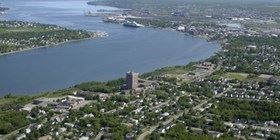News release
For immediate distribution
Harbor Port Development Partners and Cape Breton & Central Nova Scotia Railway to work together on the port of Sydney development project.
Cape Breton, Nova Scotia, November 19, 2015 — Cape Breton Regional Municipality has recently officially granted Harbor-Port Development Partners (HPDP) the exclusive right to market the port of Sydney for development, including building the financial and operating consortium to construct a state of the art container terminal and logistic park able to accommodate the latest generation of ultra large container vessels.
Cape Breton & Central Nova Scotia Railway Limited (CBNS) is in discussions with HPDP regarding the possibility of providing future rail service on the line from Truro to Sydney, Nova Scotia, as part of the deep water port development project in Sydney.
“We look forward to working with CBNS in building out our gateway and transshipment plans. This paves the way for HPDP and the Port of Sydney to move forward with additional feasibility studies and negotiations with other strategic partners,” said Albert Barbusci, Chief Executive Officer, Harbor-Port Development Partners.
Although the railway has received approval from the Nova Scotia Utility and Review Board to discontinue rail service on the portion of its rail line between St. Peter’s Junction and Sydney, Cape Breton & Central Nova Scotia Railway Limited executives have instead decided to work cooperatively with HPDP to further common goals, including the promotion of the container terminal and the re-commencement of rail service from the terminal lands in the future.
“We look forward to explore the feasibility of this project from a potential transportation partner prospective. CBNS is an important employer in the province and if this project materializes it may constitute an important step to secure the future of the Cape Breton line,” said Louis Gravel, President of CBNS.
Cape Breton Regional Municipality Mayor Cecil Clarke also welcomed the announcement. “Harbor-Port Development Partners are driving a private-sector led development that is gaining momentum. The involvement of CBNS allows all partners to work towards a long term opportunity,” he stated.
About Harbor Port Development Partners
Harbor Port Development Partners was established specifically to develop and market Sydney's new deep water container port and adjacent logistics park. HPDP is charged with assembling a consortium of marine and financial service partners to realize this important project. HPDP is in discussion with port operators, investment houses, banks, developers, port technology providers, marine engineering specialists and shipping lines in Asia, Europe, North America and the Middle East. Recently, HPDP played a role in attracting McKeil Marine and their partner Heddle Marine to the Sydney Harbour.
For more information, visit hpdp.ca.
About CBNS
CBNS runs 245 miles of track from Truro to Sydney, Nova Scotia and interchanges with CN and SCR. Primary commodities moving on the CBNS are paper, coal, lumber, petroleum product and chemicals.
For more information, visit
https://www.gwrr.com/operations/railroads/north_america/cape_breton_central_nova_scotia_railway
For immediate distribution
Harbor Port Development Partners and Cape Breton & Central Nova Scotia Railway to work together on the port of Sydney development project.
Cape Breton, Nova Scotia, November 19, 2015 — Cape Breton Regional Municipality has recently officially granted Harbor-Port Development Partners (HPDP) the exclusive right to market the port of Sydney for development, including building the financial and operating consortium to construct a state of the art container terminal and logistic park able to accommodate the latest generation of ultra large container vessels.
Cape Breton & Central Nova Scotia Railway Limited (CBNS) is in discussions with HPDP regarding the possibility of providing future rail service on the line from Truro to Sydney, Nova Scotia, as part of the deep water port development project in Sydney.
“We look forward to working with CBNS in building out our gateway and transshipment plans. This paves the way for HPDP and the Port of Sydney to move forward with additional feasibility studies and negotiations with other strategic partners,” said Albert Barbusci, Chief Executive Officer, Harbor-Port Development Partners.
Although the railway has received approval from the Nova Scotia Utility and Review Board to discontinue rail service on the portion of its rail line between St. Peter’s Junction and Sydney, Cape Breton & Central Nova Scotia Railway Limited executives have instead decided to work cooperatively with HPDP to further common goals, including the promotion of the container terminal and the re-commencement of rail service from the terminal lands in the future.
“We look forward to explore the feasibility of this project from a potential transportation partner prospective. CBNS is an important employer in the province and if this project materializes it may constitute an important step to secure the future of the Cape Breton line,” said Louis Gravel, President of CBNS.
Cape Breton Regional Municipality Mayor Cecil Clarke also welcomed the announcement. “Harbor-Port Development Partners are driving a private-sector led development that is gaining momentum. The involvement of CBNS allows all partners to work towards a long term opportunity,” he stated.
About Harbor Port Development Partners
Harbor Port Development Partners was established specifically to develop and market Sydney's new deep water container port and adjacent logistics park. HPDP is charged with assembling a consortium of marine and financial service partners to realize this important project. HPDP is in discussion with port operators, investment houses, banks, developers, port technology providers, marine engineering specialists and shipping lines in Asia, Europe, North America and the Middle East. Recently, HPDP played a role in attracting McKeil Marine and their partner Heddle Marine to the Sydney Harbour.
For more information, visit hpdp.ca.
About CBNS
CBNS runs 245 miles of track from Truro to Sydney, Nova Scotia and interchanges with CN and SCR. Primary commodities moving on the CBNS are paper, coal, lumber, petroleum product and chemicals.
For more information, visit
https://www.gwrr.com/operations/railroads/north_america/cape_breton_central_nova_scotia_railway





24
Log In or Sign Up to add a comment.- 1
arrow-eseek-e1 - 10 of 10 itemsFacebook Comments